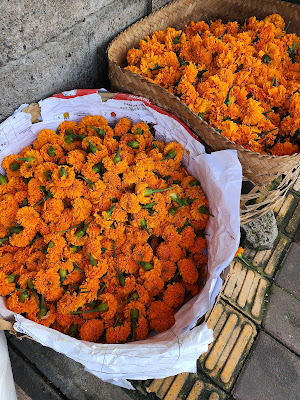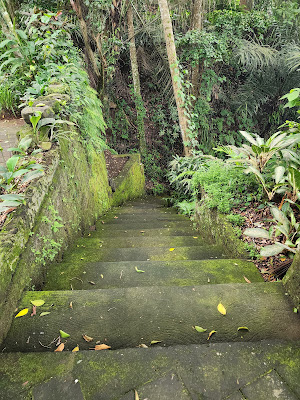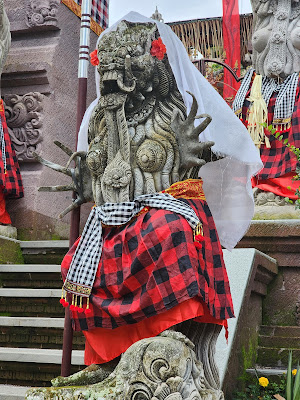After I got
 |
| Tirta Empul - holy spring |
On the way back to the main courtyard, I noticed a large koi pond in another enclosure and ventured in to take a look. I'm not sure I've ever seen so many koi at one time. You can purchase food for them, and they go crazy when you throw it in.
When exiting the temple, tourists are routed into a maze of market stalls, the vendors all asking you to "look please", "shopping, yes", "buy for good luck". There are some deals to be had here, but make sure you bargain. This used to be where you could purchase beautiful hand-crocheted tablecloths and bed covers, but the only crocheted things we saw were dresses, halter tops, and swimsuits. Once you get through that, there are the fruit vendors in the parking lot. Some of these will quickly peel a banana or some other fruit and before you know it, it's in your hand. Just know that you are never obligated to buy.
Back in the car, we headed off to a coffee plantation. This was an interesting tourist trap consisting of a guided walk through the grounds, where the guide pointed out various types of plants - cocoa, coffee, vanilla, mangosteen, etc. We were then given a glimpse of the luwak (Asian palm civet), the animal that eats the coffee cherries that become Kopi Luwak - the most expensive coffee in the world. The next stop was an information center where the whole process is explained. Beans were being roasted and ground by hand, and we could have tried our hand at it, but it had started raining and it was getting chilly, so we moved on.
We were then taken to a large pavilion where our guide handed us off to one of the sales staff. She brought out a tray with 13 cups of various coffees, teas, and hot chocolate for us to sample. The surprising favorite was avocado coffee, with vanilla and coconut coming in second. The hot chocolate looked thick and rich, but really didn't have the flavor I was expecting. Cups of Kopi Luwak were available for 50,000 each, but not being a big coffee drinker, I didn't think it was worthwhile for me to try it.
After our sampling, we were directed into the store where all the beverages we had just tried were available for sale - powdered mixes with soy milk and honey already included, just add water. Kopi Luwak was also offered for sale, but the prices were extravagant (over 1 million rupiah - $78 - for about 200 grams, if I remember correctly), so we purchased elsewhere. We did pick up a package of the avocado coffee, though.
Continuing our big day out, we headed further inland toward Kintamani. We had hoped to find kites and painted bed covers along the way, but all the shops appeared to be long closed. The only thing we saw for sale along the road was durian.
 |
| Mount Batur |
Arriving in Kintamani, we were stopped and had to pay 50,000 each tourist fee to enter the town. This is not unusual when visiting villages that have a particular draw for tourists. Kintamani's claim to fame is that it overlooks the caldera and Mount Batur. Batur last erupted in 1963, and the lava field is still visible - at least when it's not raining.
We stopped and had a buffet lunch (150,000 per person - about $10) while the rain continued to pour down. It was windy and cold. OK, it was 71 degrees, but with the wind and being used to upper 80's, it felt cold. The clouds did finally clear enough for us to see Batur and get a few pictures, then we got back in the car and headed home. No dinner tonight since we stuffed ourselves at lunch.


















































